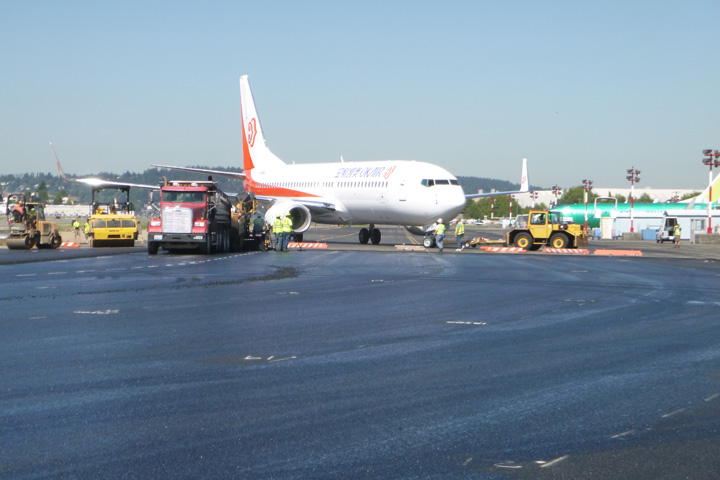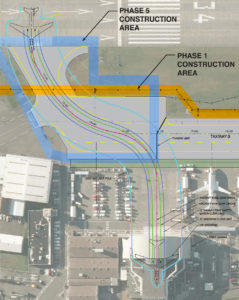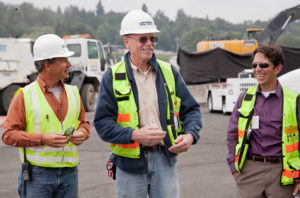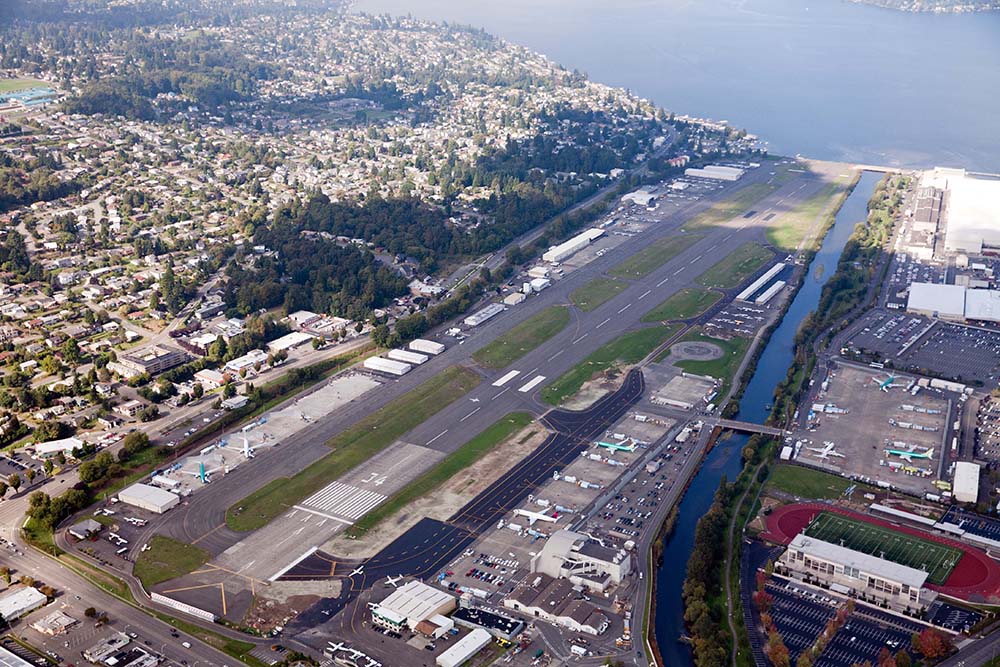Aerial photo of completed taxiway rehabilitation, taken September 2013.
How do you rehabilitate a primary taxiway that serves aircraft manufacturing and general aviation operations, without impacting plane delivery schedules and flight access during the height of the summer season?
This was the challenge on our recently completed Taxiway Bravo Rehabilitation Project at the Renton Municipal Airport/Clayton Scott Field.
The Taxiway Bravo Project
Taxiway Bravo was originally built in the 1940s. The taxiway is 3,500 feet long and serves large Boeing 737 aircraft manufacturing operations as well as general aviation usage. Although some rehabilitation and utility improvements had been done over the years, the pavement and infrastructure was in need of significant rehabilitation to support the long-term operational needs of the airport and bring the taxiway up to current FAA standards.
The primary purpose of the project was to rehabilitate the taxiway pavements that were deteriorating and failing from subgrade issues undermining the surface. Rehabilitation of the taxiway included correcting the subgrade issues, strengthening the pavement to support existing aircraft usage, and configuring the taxiway to current FAA standards.
Other upgrades included storm drainage system improvements to improve storm water quality; replacing the fire water system; and replacing the taxiway lighting and signage system with LED fixtures to reduce energy usage and facility operating costs. In addition, all of the connecting taxiways around the airport have been re-designated, improving communications between pilots and the Air Traffic Control Tower.
Overcoming Challenges
An enjoyable part of an airport design engineer’s job is facing challenges, determining a path through, and experiencing a positive outcome. This project had many unique challenges that required thoughtful design solutions and a highly coordinated project management effort. These challenges included:
- Determining how best to reconcile a pavement section significantly compromised by natural subgrade issues arising from old river bed soils, compounded by collapsed storm drain pipes, and a leaking water system.
- Balancing Boeing and tenant operational requirements with this major taxiway renovation. General aviation tenant operations and Boeing manufacturing require use of Taxiway Bravo to access the airfield, and Boeing’s work stations and paint hangar for the 737s are located directly off the taxiway. These operational needs affected the design, project phasing, and allowable construction time.

Managing for success required continually weighing each challenge against the original goals and parameters of the project, seizing opportunities that arose, and continually fostering the relationship with stakeholders and jurisdictional lead agencies. Some of our solutions included:
- Project phase limits defined to minimize the number of pavement construction joints while also minimizing closure periods of aircraft operational areas.
- Temporary taxiways installed to reduce the number of project phases and shorten the overall project duration, while improving runway access during the project.
- Aircraft movements modeled to maximize the amount of work within a given area, while still maintaining access to critical manufacturing sites.
- Design parameters established for the pavement section reconstruction based on providing the best long-term construction method and lessening the construction period.

A 24/7 Summer Schedule
Because the construction schedule did not allow for lengthy phasing on any individual portion of work, each project phase required significant construction management coverage to address construction questions and issues without delaying construction operations. Our team routinely worked double shifts to staff a 24/7 construction schedule to adequately provide construction coverage and support the project requirements.
“How many hours did you work last week?” This question was asked of the project team when one of us made a rare appearance in the office over the summer. As I wrote this blog, I remembered a funny “life lesson” from George Costanza (of the television show Seinfeld); were we really busy or only appearing to be?
No question for the construction management team; we were busy!
A rewarding part of any project is seeing what you designed on a computer screen become a reality. Seeing a constructed project take shape is what drives us to enjoy the intensity of an aggressive construction schedule.
Close Team Coordination
On occasion, I will bring my kids into the office with me. When we get home, their mom will ask, “Well, what do you think of what Dad does at work?” The response from my kids is, “Dad doesn’t really do much work. He just talks on the phone all day!” Sometimes that is the way it seems, and on this project (really, most projects), communication and close team coordination was essential to our success.
In addition to our staff, the construction management team included Renton Airport staff, Air Traffic Control Tower staff, Boeing representatives, the FAA project manager, the contractor, and other airport stakeholders. Recognizing the significant number of stakeholders and complex needs and requirements of each, we held regular stakeholder meetings to maintain communication, work through complex challenges, manage project risks, and maintain safety. Communication, project status reports, and maintaining meeting minutes proved crucial to achieving project goals and schedule.
Taking Ownership in Success
The personal ownership our team took in this project was the key to our construction management success. All field personnel were involved in the design and subsequently had a desire to see it take shape in the field. Aligning the strengths and expertise of each individual with specific roles in managing the construction provided for thorough and effective management where time was in short supply. Where people are naturally able to take ownership and operate in roles well-suited to them, the significant hours and coverage level for a project of this nature becomes less of a burden, and more of a short-term enjoyable opportunity.

In the end, we had a rewarding summer, delivering a well-constructed project on time and under budget, that will support long term aircraft manufacturing and general aviation activities with improved safety at the Renton Municipal Airport/Clayton Scott Field.


